Effects of Establishment on Growth, Yield, and Silage Qualities of Amaranth in Typhoon-Prone Southern Kyushu, Japan
Abstract
:1. Introduction
2. Materials and Methods
2.1. Study Area
2.2. Experimental Design and Forage Preparation
2.3. Silage Preparation
2.4. Forage Quality Analysis for Plant Samples and Silage
2.5. Statistical Analysis
3. Results
3.1. Establishment Rate
3.2. Changes in Shoot Density
3.3. Changes in Plant Height
3.4. DM Yields and CGR in 2021–2023
3.5. Herbage Quality of In Vitro Digestibility of DM and CP Content in 2022
3.6. Silage Quality in 2021–2023
4. Discussion
4.1. Effect of Seasons and Establishment Methods on Establishment and Growth of Amaranth
4.2. Effect of Seasons and Establishment Methods on Amaranth Yield, Herbage Quality, and Silage Fermentation Quality
5. Conclusions
Author Contributions
Funding
Institutional Review Board Statement
Data Availability Statement
Conflicts of Interest
References
- Matías, J.; Rodríguez, M.J.; Carrillo-Vico, A.; Casals, J.; Fondevilla, S.; Haros, C.M.; Pedroche, J.; Aparicio, N.; Fernández-García, N.; Aguiló-Aguayo, I.; et al. From ‘Farm to Fork’: Exploring the Potential of Nutrient-Rich and Stress-Resilient Emergent Crops for Sustainable and Healthy Food in the Mediterranean Region in the Face of Climate Change Challenges. Plants 2024, 13, 1914. [Google Scholar] [CrossRef]
- Assad, R.; Reshi, Z.A.; Jan, S.; Rashid, I. Biology of Amaranths. Bot. Rev. 2017, 83, 382–436. [Google Scholar] [CrossRef]
- Pospišil, A.; Pospišil, M.; Maćešić, D.; Svečnjak, Z. Yield and quality of forage sorghum and different amaranth species (Amaranthus spp.) biomass. Agric. Conspec. Sci. 2009, 74, 85–89. Available online: https://acs.agr.hr/acs/index.php/acs/article/view/5 (accessed on 31 March 2024).
- Rezaei, J.; Rouzbehan, Y.; Zahedifar, M.; Fazaeli, H. Effects of dietary substitution of maize silage by amaranth silage on feed intake, digestibility, microbial nitrogen, blood parameters, milk production and nitrogen retention in lactating Holstein cows. Anim. Feed Sci. Technol. 2015, 202, 32–41. [Google Scholar] [CrossRef]
- Ma, J.; Sun, G.; Shah, A.M.; Fan, X.; Li, S.; Yu, X. Effects of different growth stages of amaranth silage on the rumen degradation of dairy cows. Animals 2019, 9, 793. [Google Scholar] [CrossRef]
- Baghdadi, A.; Golzardi, F.; Hashemi, M. The use of alternative irrigation and cropping systems in forage production may alleviate the water scarcity in semi-arid regions. J. Sci. Food Agric. 2023, 103, 5050–5060. [Google Scholar] [CrossRef]
- Hosseini, S.A.; Rouzbehan, Y.; Fazaeli, H.; Rezaei, J. Comparing the yield and nutritional value of ensiled amaranth (Amaranthus hypochondriacus) cultivars with corn silage (Zea mays) in doublecropping condition. Transl. Anim. Sci. 2023, 7, 158. [Google Scholar] [CrossRef]
- Lotfi, S.; Rouzbehan, Y.; Fazaeli, H.; Feyzbakhsh, M.T.; Rezaei, J. The nutritional value and yields of amaranth (Amaranthus hypochondriacus) cultivar silages compared to silage from corn (Zea mays) harvested at the milk stage grown in a hot-humid climate. Anim. Feed. Sci. Technol. 2022, 289, 115336. [Google Scholar] [CrossRef]
- Svirskis, A. Prospects for non-traditional plant species cultivated for forage in Lithuania. Not. Bot. Horti Agrobot. Cluj-Napoca 2009, 37, 215–218. Available online: https://www.scopus.com/inward/record.uri?eid=2-s2.0-67649245959&partnerID=40&md5=6e276b0906bc4837d2cf4079c407fef0 (accessed on 30 March 2024).
- Honda, H.; Mukasa, Y.; Suzuki, T. Effect of planting density on amaranth. Jpn. Soc. Breed./Crop Sci. Soc. Jpn. Hokkaido Discourse Bull. 2001, 42, 135–136. [Google Scholar]
- Nakui, T.; Yahara, N.; Takai, S. The influence of the lodging on harvest loss, fermentation quality and palatability of corn silage. Tohoku Agric. Res. 1983, 33, 171–172. [Google Scholar]
- Waki, D. Machinery harvest and processing against typhoon risk in Kagoshima Prefecture. Rep. Kyushu Branch Jpn. Soc. Grassl. Sci. 1999, 29, 30–32. [Google Scholar]
- Aoki, T. Lodging of forages and its cultivation management in Kagoshima Prefecture. Rep. Kyushu Branch Jpn. Soc. Grassl. Sci. 1999, 29, 19–23. [Google Scholar]
- Kato, N.; Hattori, I.; Kikkawa, Y.; Kaneko, M.; Katsura, M.; Takai, T.; Arakawa, A.; Uwatoko, N. Mitigation of the typhoon risk on the forage crop production in the southern Kyushu Japan by introducing multiple cropping system. Jpn. J. Grassl. Sci. 2021, 66, 242–247. [Google Scholar]
- Li, B.; Ishii, Y.; Idota, S.; Tobisa, M.; Niimi, M.; Yang, Y.; Nishimura, K. Yield and quality of forages in a triple cropping system in southern Kyushu, Japan. Agronomy 2019, 9, 277. [Google Scholar] [CrossRef]
- Li, B.; Ishii, Y.; Idota, S.; Yang, Y.; Niimi, M. Growth and yield potentials of pearl millet (Pennisetum typhoides) under different sowing dates in southern Kyushu, Japan. Wulfenia J. 2020, 27, 67–80. [Google Scholar]
- Baturaygil, A.; Stetter, M.G.; Schmid, K. Breeding amaranth for biomass: Evaluating dry matter content and biomass potential in early and late maturing genotypes. Agronomy 2021, 11, 970. [Google Scholar] [CrossRef]
- Dunière, L.; Sindou, J.; Chaucheyras-Durand, F.; Chevallier, I.; Thévenot-Sergentet, D. Silage processing and strategies to prevent persistence of undesirable microorganisms. Anim. Feed Sci. Technol. 2013, 182, 1–15. [Google Scholar] [CrossRef]
- Guo, X.S.; Undersander, D.J.; Combs, D.K. Effect of Lactobacillus inoculants and forage dry matter on the fermentation and aerobic stability of ensiled mixed-crop tall fescue and meadow fescue. J. Dairy Sci. 2013, 96, 1735–1744. [Google Scholar] [CrossRef]
- Liu, Y.F.; Qui, H.R.; Yu, X.; Sun, G.; Ma, J.; Zhang, D.L.; Senbati, H. Effects of addition of lactic acid bacteria, glucose, and formic acid on the quality of Amatanthus hypochondriacus silage. Acta Prataculturae Sin. 2017, 26, 214–220. [Google Scholar] [CrossRef]
- Ma, J.; Sun, G.Q.; Kurban, C.; Zhao, S.S.; Qiu, H.R.; Heilimubuick, S.; Li, S.L.; Yu, X. Effect of growth stage on the quality of hay and silage of Amaranthus hypochondriacus. Pratacultural Sci. 2019, 36, 871–877. [Google Scholar] [CrossRef]
- Lavallee, K.; Soti, P.G.; Rodrigo, H.; Kariyat, R.; Racelis, A. Pre-sowing treatments improve germinability of south Texas native plant seeds. Plants 2021, 10, 2545. [Google Scholar] [CrossRef]
- Kannan, R.; Dhivya, V.; Janani, T.S.K. Future perspective of seed ball technology for creating new ecosystem. Int. J. Plant Environ. 2021, 7, 293–296. [Google Scholar] [CrossRef]
- Japan Meteorological Agency. Available online: https://www.jma.go.jp/jma/index.html (accessed on 20 June 2024).
- Goto, I.; Minson, D.J. Prediction of the day matter digestibility of tropical grasses using a pepsin-cellulase assay. Anim. Feed Sci. Technol. 1997, 2, 247–253. [Google Scholar] [CrossRef]
- Kjeldahl, J. New method for the determination of nitrogen. Chem. News 1883, 48, 101–102. [Google Scholar] [CrossRef]
- Yeh, C.S. Rapid micro-determination of nitrogen by the Dumas method. Microchem. J. 1966, 11, 229–236. [Google Scholar] [CrossRef]
- Barker, S.B.; Summerson, W.H. The colorimetric determination of lactic acid in biological material. J. Biol. Chem. 1941, 138, 535–554. [Google Scholar] [CrossRef]
- Conway, E.J.; Byrne, A. An absorption apparatus for the micro-determination of certain volatile substances: The micro-determination of ammonia. Biochem. J. 1933, 27, 419–429. [Google Scholar] [PubMed] [PubMed Central]
- Anokhina, E.; Obraztsova, S.; Tolkacheva, A.; Cherenkov, D.; Sviridova, T.; Korneeva, O. Development of a lactic bacteria starter for amaranth silage and investigation of its influence on silage quality. Agriculture 2023, 13, 1534. [Google Scholar] [CrossRef]
- Mu, L.; Xie, Z.; Hu, L.; Chen, G.; Zhang, Z. Cellulase interacts with Lactobacillus plantarum to affect chemical composition, bacterial communities, and aerobic stability in mixed silage of high-moisture amaranth and rice straw. Bioresour. Technol. 2020, 315, 123772. [Google Scholar] [CrossRef]
- Niimi, M.; Hanabusa, Y.; Kawamura, O. Effect of glucose addition on the silage fermentation of guineagrass (Panicum maximum Jacq.), especially in reference to degradation of hemicellulose. Rep. Kyushu Branch Jpn. Soc. Grassl. Sci. 2008, 38, 18–23. [Google Scholar]
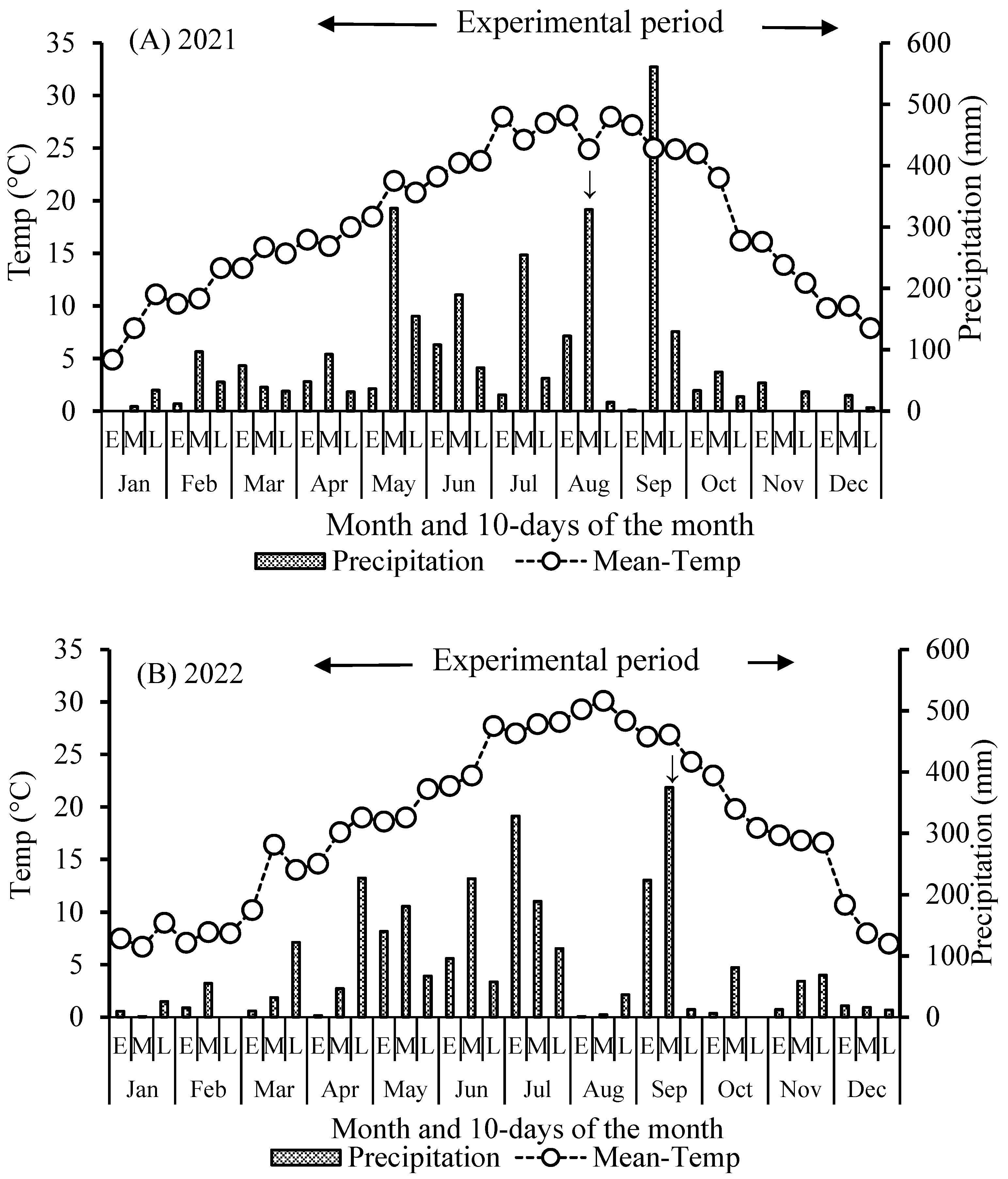
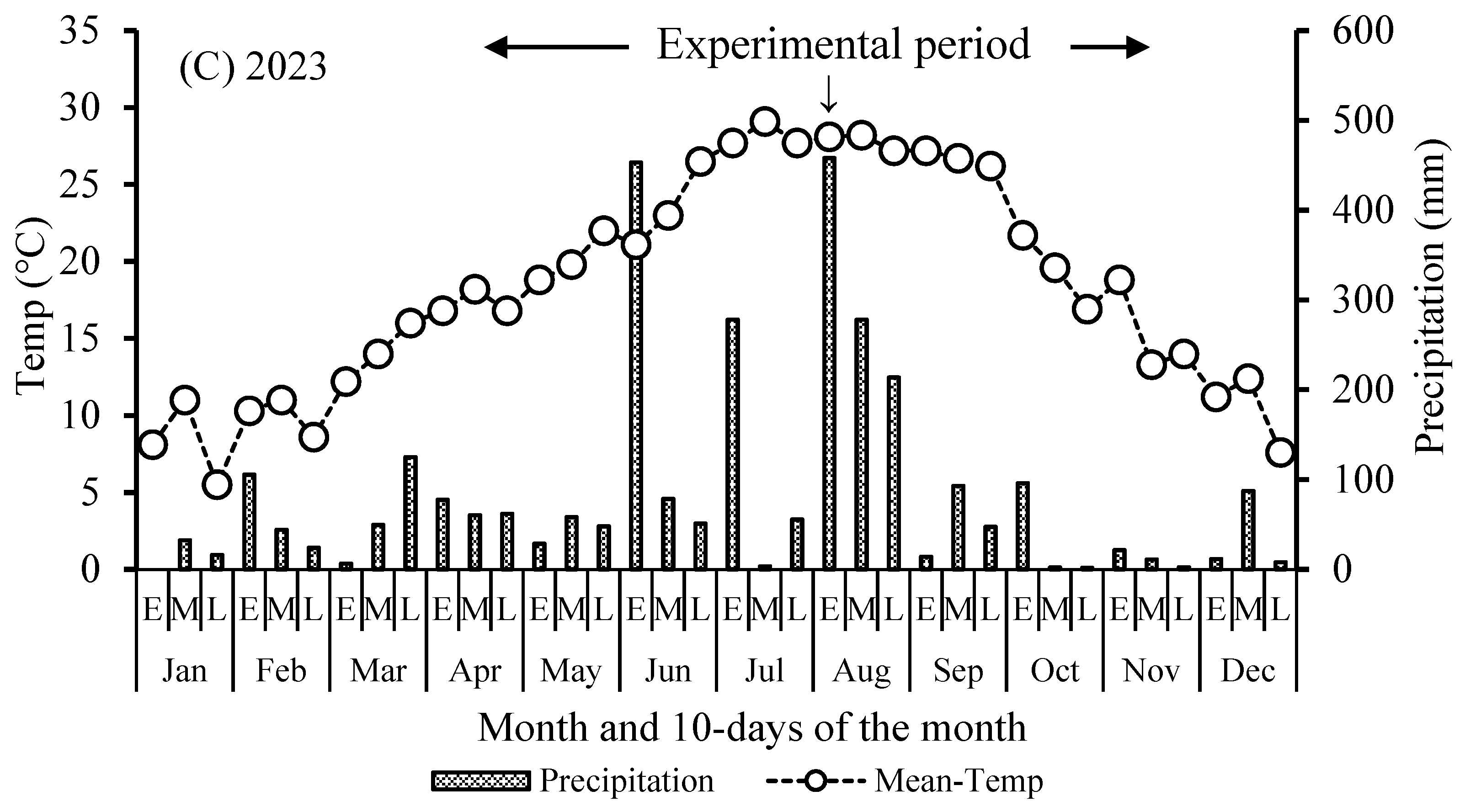
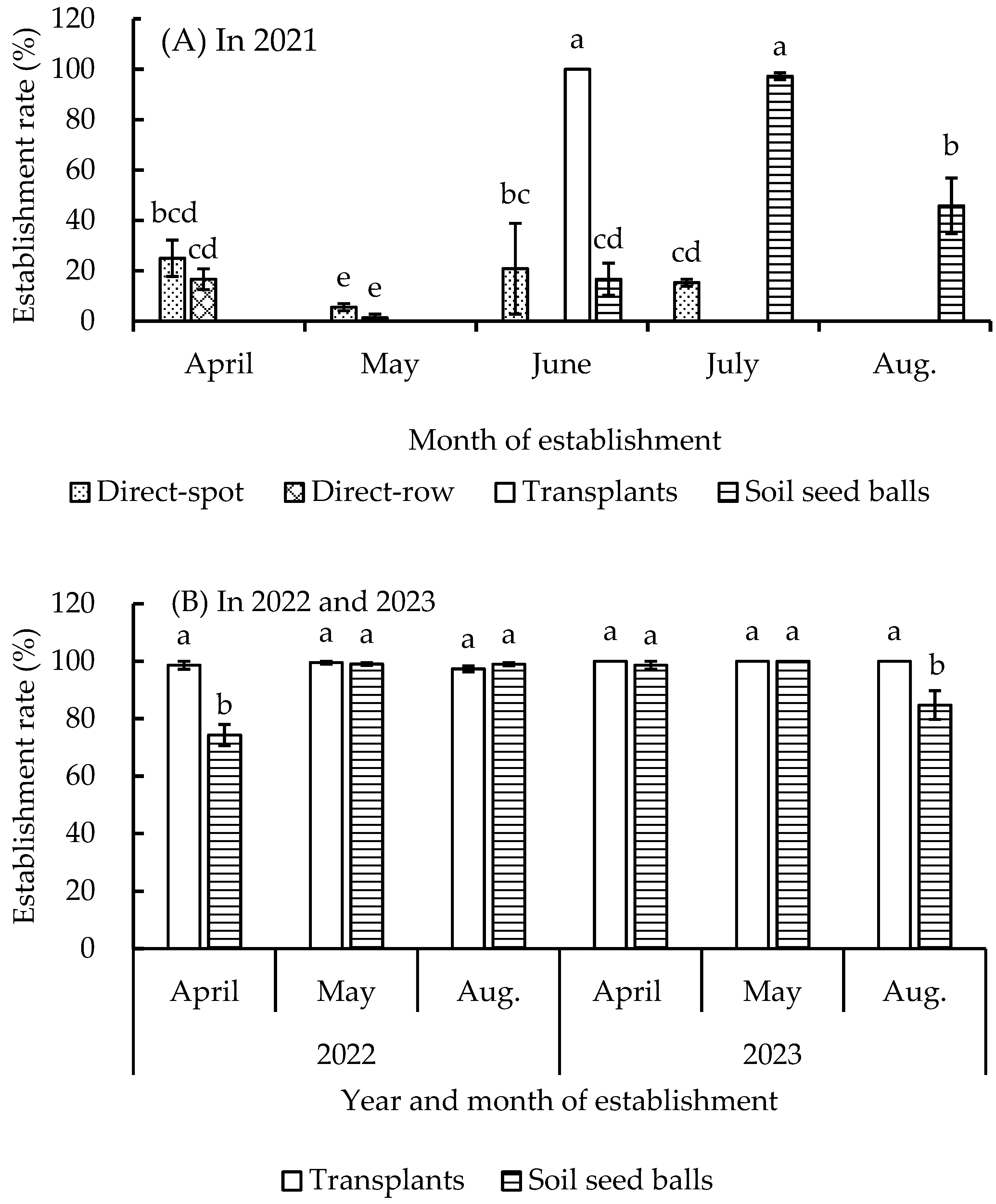
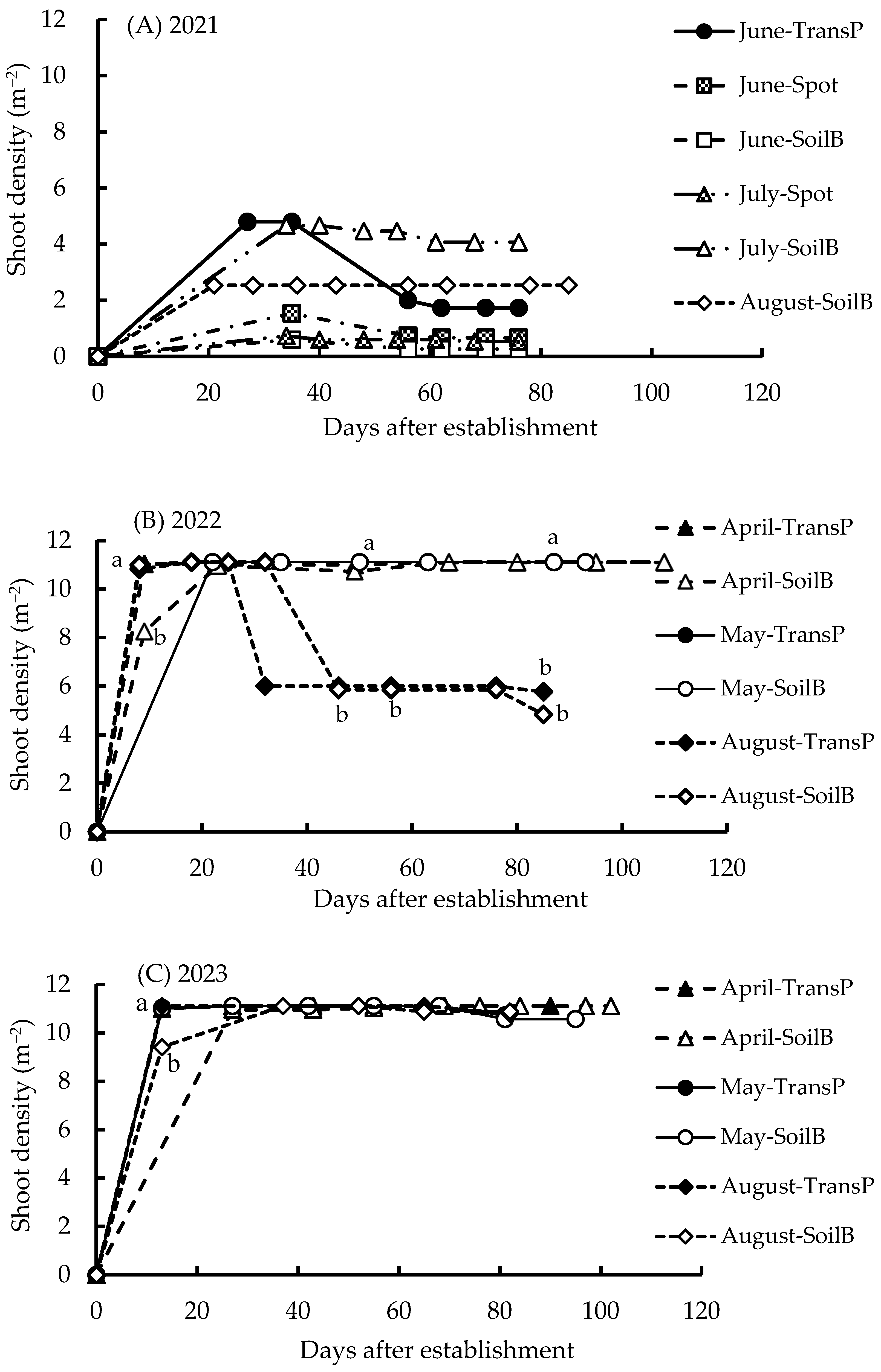
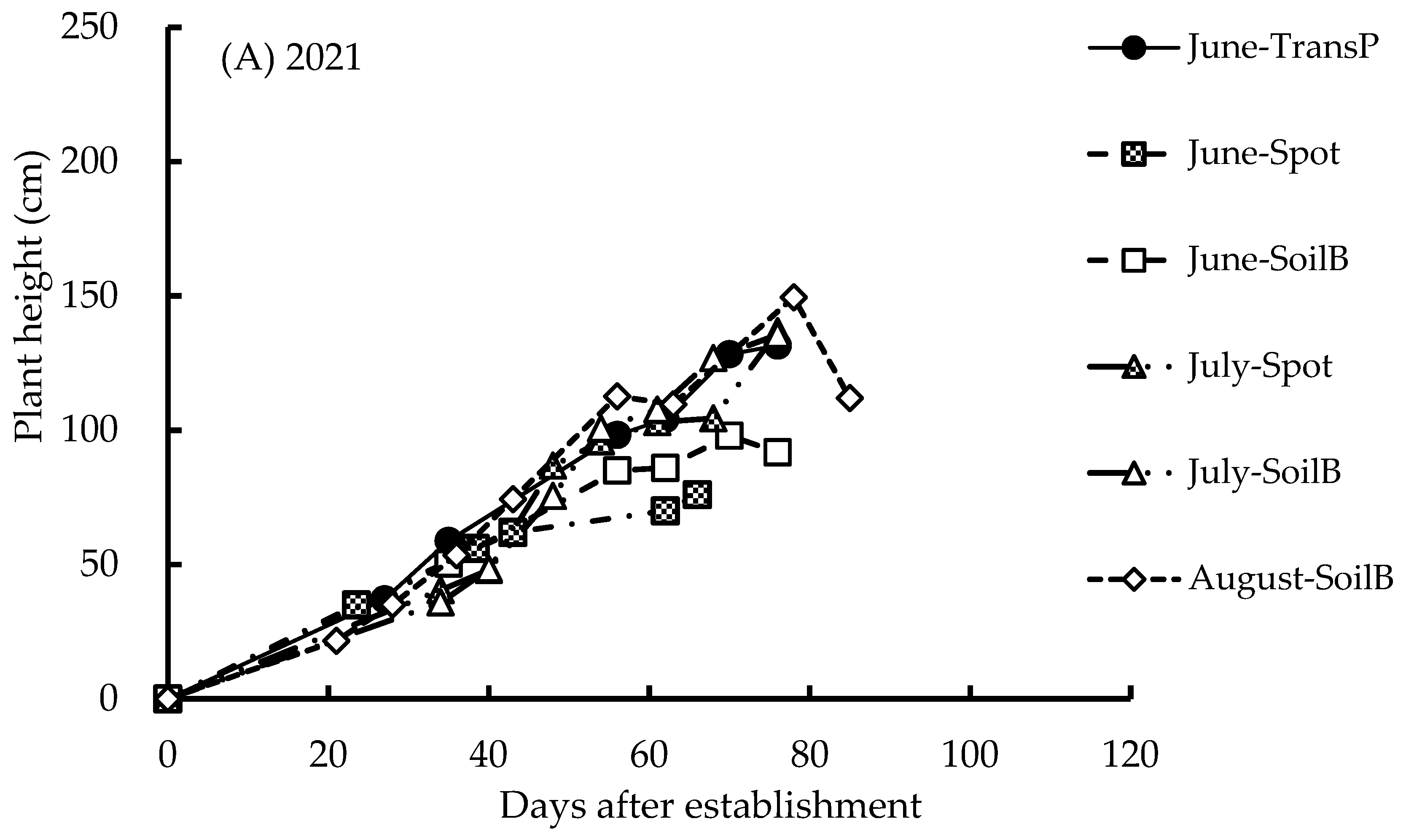
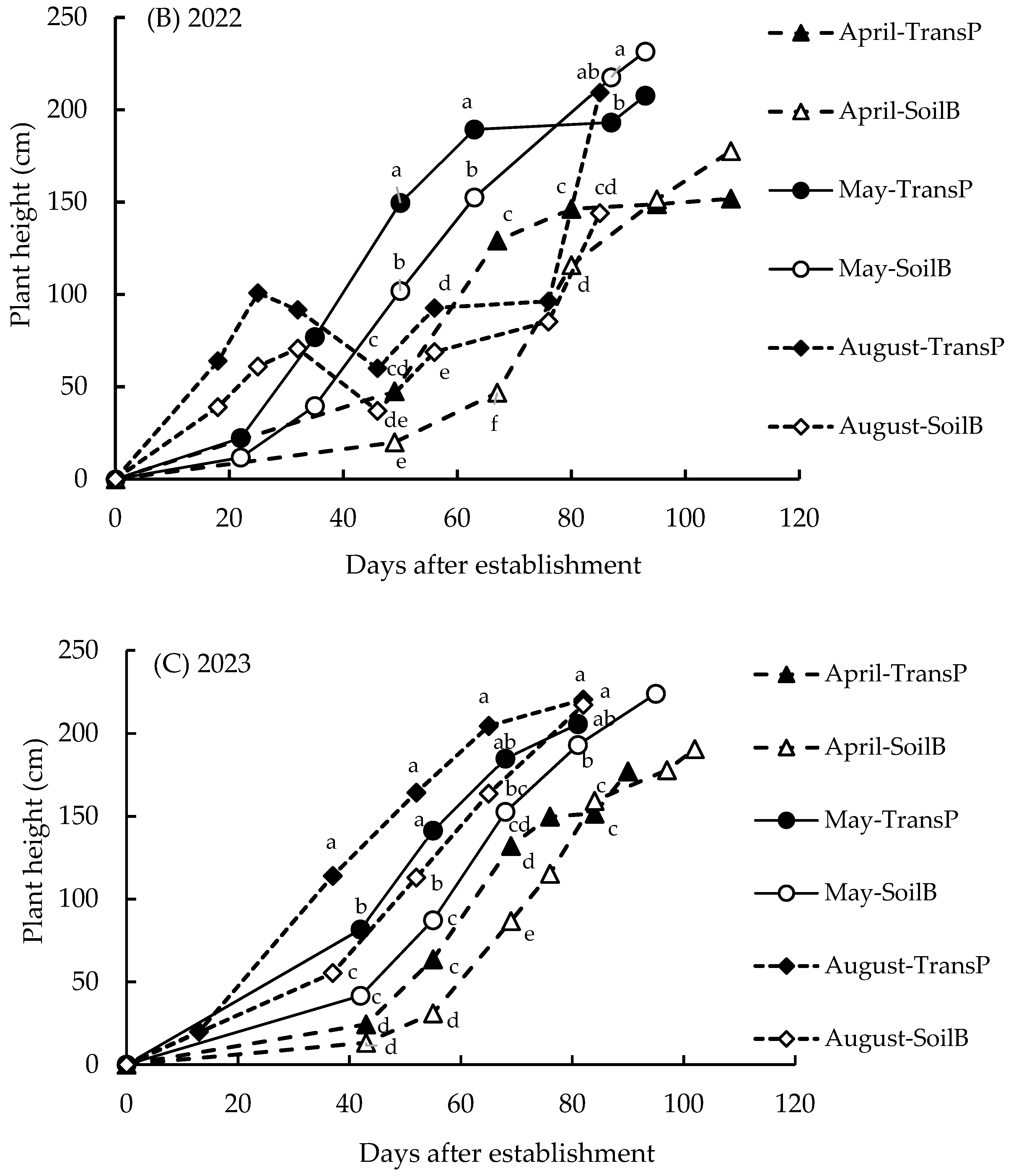
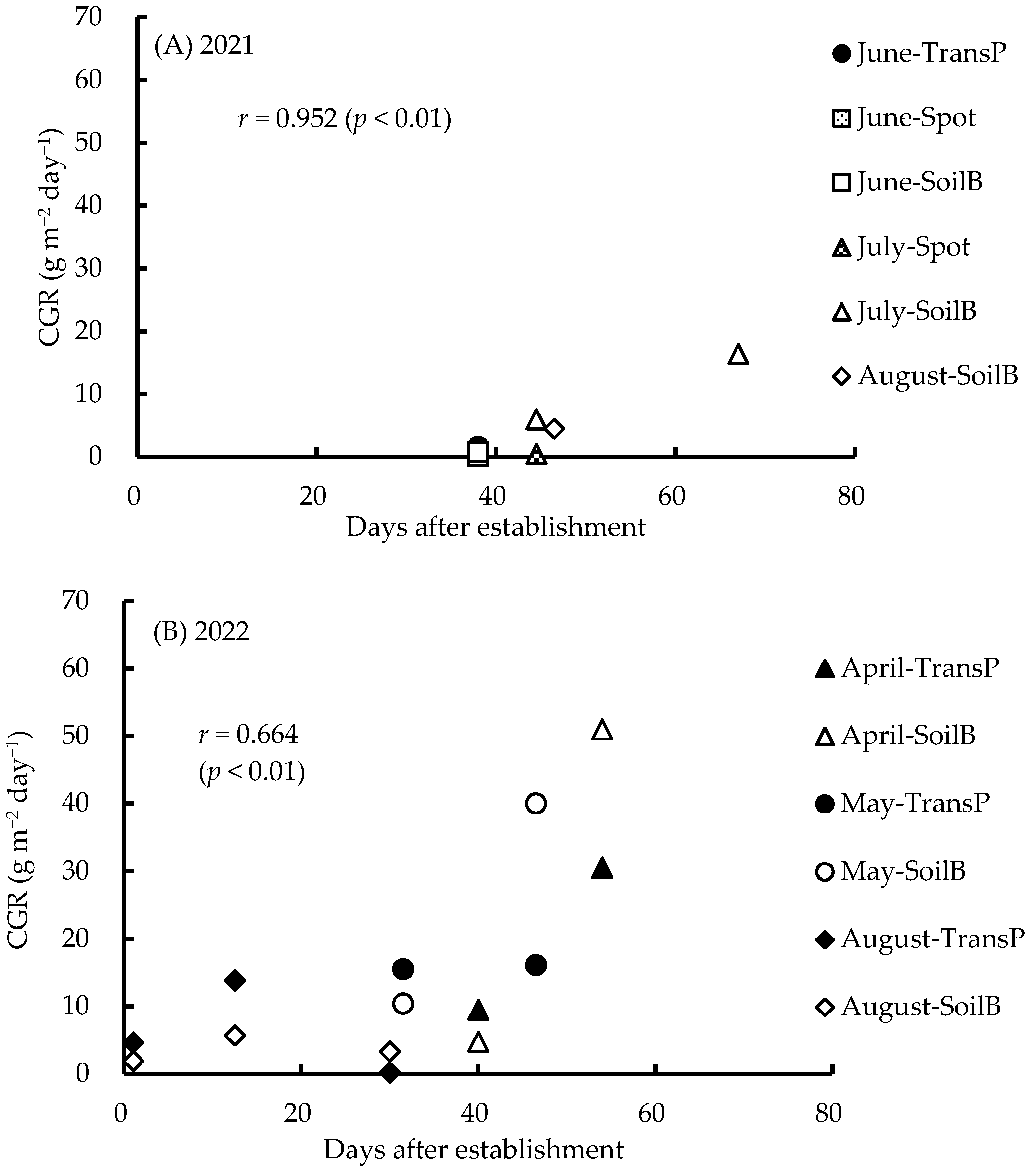
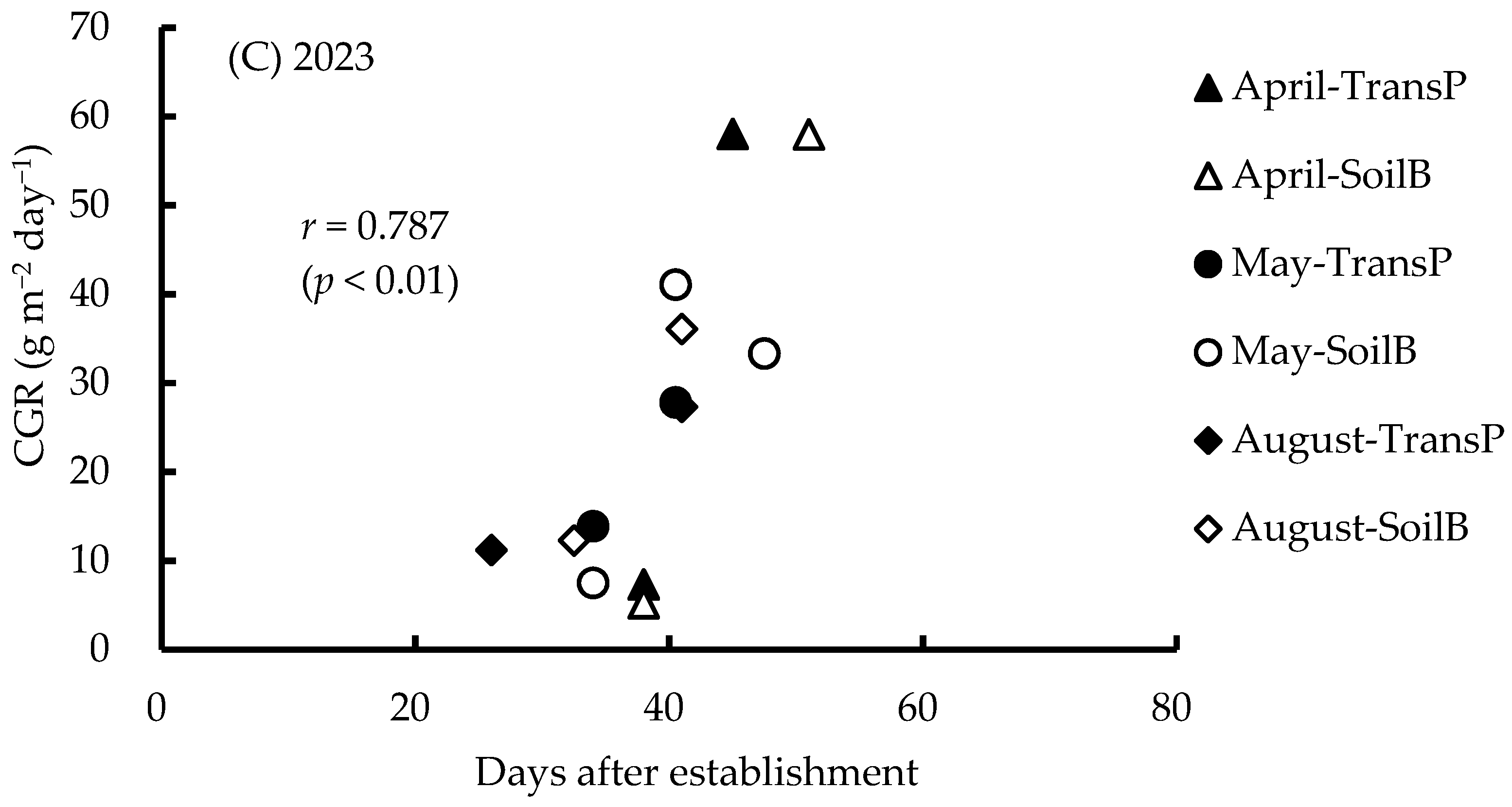
| Year | Date of Establishment | Method of Establishment | Abbreviation of Establishment | Plant Spacing | Sowing Date | Harvest Stage of Amaranth |
|---|---|---|---|---|---|---|
| 2021 | 14 April | Direct seeding in row | April-Row | 40 cm † | 14 April | Late flowering |
| Direct seeding in spot ⁑ | April-Spot | 40 cm × 40 cm | 14 April | |||
| 11 May | Direct seeding in row | May-Row | 40 cm † | 11 May | ||
| Direct seeding in spot | May-Spot | 40 cm × 40 cm | 11 May | |||
| 29 June | Transplants | June-TransP | 40 cm × 40 cm | 11 May | ||
| Direct seeding in spot | June-Spot | 40 cm × 40 cm | 29 June | |||
| Soil seed balls | June-SoilB | 40 cm × 40 cm | 26 June | |||
| 21 July | Direct seeding in spot | July-Spot | 40 cm × 40 cm | 21 July | ||
| Soil seed balls | July-SoilB | 40 cm × 40 cm | 20 July | |||
| 30 August | Soil seed balls | August-SoilB | 40 cm × 40 cm | 29 August | ||
| 2022 | 9 April | Transplants | April-TransP | 30 cm × 30 cm | 14 March | Full maturity |
| Soil seed balls | April-SoilB | 30 cm × 30 cm | 8 April | |||
| 22 May | Transplants | May-TransP | 30 cm × 30 cm | 25 April | ||
| 23 May | Soil seed balls | May-SoilB | 30 cm × 30 cm | 22 May | ||
| 11 August | Transplants | August-TransP | 30 cm × 30 cm | 18 July | ||
| Soil seed balls | August-SoilB | 30 cm × 30 cm | 10 August | |||
| 2023 | 11 April | Transplants | April-TransP | 30 cm × 30 cm | 15 March | Full maturity |
| Soil seed balls | April-SoilB | 30 cm × 30 cm | 9 April | |||
| 23 May | Transplants | May-TransP | 30 cm × 30 cm | 20 April | ||
| Soil seed balls | May-SoilB | 30 cm × 30 cm | 22 May | |||
| 19 August | Transplants | August-TransP | 30 cm × 30 cm | 17 July | ||
| Soil seed balls | August-SoilB | 30 cm × 30 cm | 18 August |
| (A) 2021 | ||||||||||
| Establishment Method | Harvest Date | Maturity at Harvest | Plant Height (cm) | Plant Density (m−2) | Fresh Yield (g m−2) | Dry Matter Yield (g m−2) | Lodging by Typhoon (%) | |||
| Leaves | Stems | Inflo-Rescences | Whole Plants | |||||||
| June-TransP | 13 September | Early seed mature | 131.6 | 1.8 | 942.9 | 36.0 | 63.9 | 25.1 | 125.0 | 58.3 |
| June-Spot | Full-bloom | 66.0 | 0.7 | 1.7 | − | − | − | 0.4 | 53.3 | |
| June-SoilB | Full-bloom | 91.8 | 0.7 | 204.4 | 17.9 | 34.7 | 7.7 | 60.3 | 50.0 | |
| July-Spot | 18 October | Full-bloom | 136.8 | 0.3 | 439.9 | 10.8 | 14.0 | 13.1 | 38.0 | 14.3 |
| July-SoilB | 2 December | Full-mature | 135.6 | 4.1 | 7413.8 | 272.4 | 356.2 | 637.3 | 1265.9 | 4.3 |
| August-SoilB | Early seed mature | 112.0 | 2.5 | 3028.6 | 151.3 | 144.5 | 118.0 | 413.7 | 0 | |
| (B) 2022 | ||||||||||
| Establishment method | Harvest Date | Maturity at Harvest | Plant Height (cm) | Plant Density (m−2) | Fresh Yield (g m−2) | Dry Matter Yield (g m−2) | Lodging by Typhoon (%) | |||
| Leaves | Stems | Inflore-Scences | Whole Plants | |||||||
| April-TransP | 26 July | Full-mature | 151.8 ± 3.8 †d | 11.1 ± 0.0 a | 7707.4 ± 1636.4 ab | 213.3 ± 52.5 bc | 356.7 ± 61.5 c | 1042.7 ± 222.2 a | 1612.6 ± 335.5 a | 0 |
| April-SoilB | Full-mature | 177.7 ± 0.7 c | 11.1 ± 0.0 a | 11,023.7 ± 2323.7 a | 355.3 ± 67.8 a | 624.6 ± 89.3 b | 828.5 ± 223.5 a | 2043.8 ± 270.2 a | 0 | |
| May-TransP | 25 August | Full-mature | 207.7 ± 6.7 b | 11.1 ± 0.0 a | 8180.7 ± 243.9 ab | 130.7 ± 4.9 cd | 711.5 ± 51.6 ab | 618.5 ± 41.7 a | 1460.7 ± 16.9 a | 0 |
| May-SoilB | Full-mature | 231.5 ± 9.7 a | 11.1 ± 0.0 a | 11,464.8 ± 2232.5 a | 306.3 ± 37.0 ab | 903.4 ± 121.9 a | 645.4 ± 119.9 a | 1685.3 ± 286.8 a | 0 | |
| August-TransP | 4 November | Full-bloom | 209.3 ± 11.3 b | 5.8 ± 1.1 b | 4022.9 ± 717.2 bc | 85.6 ± 13.9 d | 278.2 ± 8.2 c | 103.7 ± 22.5 b | 467.5 ± 40.8 b | 46.1 |
| August-SoilB | Full-bloom | 144.0 ± 5.2 d | 5.3 ± 0.4 b | 2313.0 ± 93.2 c | 71.8 ± 6.1 d | 156.5 ± 10.1 c | 77.7 ± 15.0 b | 306.0 ± 25.4 b | 47.3 | |
| (C) 2023 | ||||||||||
| Establishment Method | HarvestDate | Maturity at Harvest | Plant Height (cm) | Plant Density (m−2) | Fresh Yield (g m−2) | Dry Matter Yield (g m−2) | Lodging by Typhoon (%) | |||
| Leaves | Stems | Inflore-Scences | Whole Plants | |||||||
| April-TransP | 10 July | Full-mature | 177.2 ± 8.3 b | 11.1 ± 0.0 ns | 8965.0 ± 303.3 c | 259.2 ± 8.6 c | 383.1 ± 29.8 c | 716.1 ± 22.9 a | 1358.4 ± 60.0 c | 0 |
| April-SoilB | 22 July | Full-mature | 190.7 ± 7.4 b | 11.1 ± 0.0 | 10,973.9 ± 601.6 abc | 355.2 ± 21.0 b | 657.6 ± 56.7 b | 881.8 ± 91.0 a | 1894.7 ± 164.7 a | 0 |
| May-TransP | 12 August | Full-mature | 205.7 ± 7.1 ab | 10.7 ± 0.3 | 9059.6 ± 450.4 bc | 279.4 ± 19.8 c | 548.4 ± 31.8 b | 477.7 ± 22.3 b | 1305.6 ± 46.8 c | 4.9 |
| May-SoilB | 26 August | Full-mature | 223.8 ± 8.4 a | 10.6 ± 0.2 | 12,090.7 ± 92.9 a | 376.7 ± 23.3 b | 904.8 ± 14.8 a | 231.1 ± 14.7 c | 1512.6 ± 31.0 bc | 3.5 |
| August-TransP | 11 November | Full-mature | 220.3 ± 9.1 a | 10.8 ± 0.2 | 10,696.7 ± 945.2 abc | 377.1 ± 11.0 b | 616.7 ± 50.1 b | 761.7 ± 94.5 a | 1755.6 ± 151.6 ab | 0 |
| August-SoilB | 11 November | Full-mature | 217.2 ± 3.5 a | 10.9 ± 0.1 | 11,039.4 ± 839.5 ab | 465.3 ± 11.6 a | 631.6 ± 55.3 b | 322.7 ± 56.7 bc | 1419.7 ± 122.1 bc | 0 |
| Treatment for Establishment | IVDMD (%) | CP (% DM) | ||||||
|---|---|---|---|---|---|---|---|---|
| Leaves | Stems | Inflore-Scences | Whole Plants | Leaves | Stems | Inflore-Scences | Whole Plants | |
| April-TransP | 63.95 ± 0.83 †e | 48.74 ± 0.43 b | 67.70 ± 0.66 bc | 62.97 ± 0.57 a | 13.81 ± 0.99 b | 3.24 ± 0.70 b | 15.41 ± 0.47 bc | 12.47 ± 0.63 bc |
| April-SoilB | 70.82 ± 0.62 bc | 48.47 ± 2.42 b | 71.47 ± 1.37 ab | 63.08 ± 1.70 a | 15.63 ± 1.29 b | 4.06 ± 1.33 b | 13.38 ± 1.00 c | 10.53 ± 1.26 cd |
| May-TransP | 66.52 ± 0.79 de | 43.37 ± 1.00 c | 60.99 ± 1.84 cd | 53.27 ± 0.20 b | 9.10 ± 1.02 c | 2.64 ± 0.58 b | 13.82 ± 1.85 c | 7.59 ± 1.23 d |
| May-SoilB | 68.33 ± 0.89 cd | 37.96 ± 1.18 d | 59.02 ± 1.14 d | 49.64 ± 1.48 b | 15.94 ± 2.25 b | 4.66 ± 1.46 b | 14.15 ± 1.71 c | 9.72 ± 1.80 cd |
| August-TransP | 73.69 ± 1.99 b | 54.99 ± 1.41 a | 78.12 ± 3.64 a | 63.10 ± 1.36 a | 22.99 ± 1.36 a | 11.44 ± 0.87 a | 19.15 ± 1.78 ab | 15.15 ± 1.33 ab |
| August-SoilB | 77.97 ± 0.54 a | 56.30 ± 0.64 a | 75.28 ± 3.22 a | 66.15 ± 1.21 a | 24.88 ± 0.71 a | 13.41 ± 0.98 a | 22.30 ± 0.41 a | 18.36 ± 0.80 a |
| Established Month and Year | July 2021 | August 2022 | August 2023 | ||
|---|---|---|---|---|---|
| Method of Establishment | Soil Seed Balls | Soil Seed Balls | Transplants | Soil Seed Balls | Transplants |
| n | 2 | 3 | 3 | 3 | 3 |
| Wilted forages | |||||
| Percentage of dry matter (DM) | 17.07 ± 0.00 b† | 25.78 ± 1.75 a | 21.95 ± 4.54 ab | 19.37 ± 0.79 ab | 24.59 ± 1.19 a |
| Silage quality attribute | |||||
| Percentage of dry matter (DM) | 19.29 ± 0.22 c | 23.30 ± 0.44 a | 22.81 ± 0.47 ab | 20.01 ± 0.79 bc | 24.30 ± 1.56 a |
| pH | 6.39 ± 0.22 a | 5.58 ± 0.33 b | 5.53 ± 0.05 b | 4.52 ± 0.04 c | 4.99 ± 0.23 bc |
| Lactic acid (g kg−1 DM) | 9.91 ± 4.09 a | 3.10 ± 0.39 b | 3.09 ± 0.49 b | 1.25 ± 0.16 b | 2.00 ± 0.70 b |
| Acetic acid (g kg−1 DM) | 6.56 ± 0.01 c | 23.69 ± 1.99 a | 16.59 ± 0.49 b | 10.43 ± 0.81 c | 8.35 ± 1.53 c |
| Propionic acid (g kg−1 DM) | 2.49 ± 0.73 ns | 1.56 ± 0.33 | 3.09 ± 0.11 | 2.04 ± 0.60 | 3.53 ± 0.85 |
| Butyric acid (g kg−1 DM) | 0.00 ± 0.00 ns | 0.13 ± 0.06 | 0.23 ± 0.13 | 0.00 ± 0.00 | 0.00 ± 0.00 |
| Valeric acid (g kg−1 DM) | 0.64 ± 0.14 b | 0.24 ± 0.12 b | 0.49 ± 0.09 b | 5.66 ± 0.31 a | 5.07 ± 0.23 a |
| Volatile basic nitrogen (VBN, g kg−1 DM) | 0.06 ± 0.06 c | 0.36 ± 0.02 a | 0.34 ± 0.01 a | 0.17 ± 0.01 b | 0.11 ± 0.01 bc |
| Total nitrogen (TN, g kg−1 DM) | 23.32 ± 1.97 ns | 28.71 ± 1.94 | 26.43 ± 0.88 | 29.71 ± 3.00 | 29.71 ± 2.21 |
| VBN/TN (%) | 0.23 ± 0.23 c | 1.27 ± 0.06 a | 1.28 ± 0.02 a | 0.58 ± 0.04 b | 0.47 ± 0.01 b |
Disclaimer/Publisher’s Note: The statements, opinions and data contained in all publications are solely those of the individual author(s) and contributor(s) and not of MDPI and/or the editor(s). MDPI and/or the editor(s) disclaim responsibility for any injury to people or property resulting from any ideas, methods, instructions or products referred to in the content. |
© 2024 by the authors. Licensee MDPI, Basel, Switzerland. This article is an open access article distributed under the terms and conditions of the Creative Commons Attribution (CC BY) license (https://creativecommons.org/licenses/by/4.0/).
Share and Cite
Zhong, Z.; Niimi, M.; Tobisa, M.; Idota, S.; Ishii, Y. Effects of Establishment on Growth, Yield, and Silage Qualities of Amaranth in Typhoon-Prone Southern Kyushu, Japan. Agriculture 2024, 14, 1364. https://doi.org/10.3390/agriculture14081364
Zhong Z, Niimi M, Tobisa M, Idota S, Ishii Y. Effects of Establishment on Growth, Yield, and Silage Qualities of Amaranth in Typhoon-Prone Southern Kyushu, Japan. Agriculture. 2024; 14(8):1364. https://doi.org/10.3390/agriculture14081364
Chicago/Turabian StyleZhong, Zixuan, Mitsuhiro Niimi, Manabu Tobisa, Sachiko Idota, and Yasuyuki Ishii. 2024. "Effects of Establishment on Growth, Yield, and Silage Qualities of Amaranth in Typhoon-Prone Southern Kyushu, Japan" Agriculture 14, no. 8: 1364. https://doi.org/10.3390/agriculture14081364





